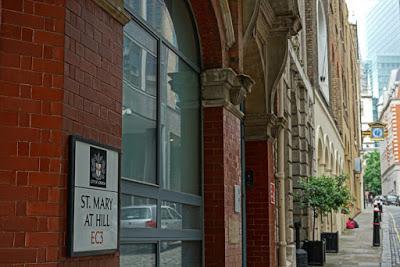
In the City of London, heading uphill from Old Billingsgate Market, is St Mary At Hill. It's not the best-known City street, and if you look at the east side, not the most interesting - modern buildings include a Premier Inn. However, the left (west) side of the road is full of fascinating buildings.

Right on the corner is a fine building bearing the words 'Reading Room & Library'. This is the former home of Billingsgate Christian Mission. Built for them in 1889-90, it offered 'a well-chosen library of 1,000 volumes' as well as gospel services, a day refuge, temperance meetings and a coffee tavern.

Seven years later, a dispensary was added to offer free first aid to market workers as well as train missionaries . In 1905, an ophthalmic ward was added, offering evening appointments between 6-8pm on Tuesdays so that poorer workers didn't have to lose pay to attend. The organisation continued here for much of the twentieth century, although missionary training ended in the 1950s and much other work moved with the Billingsgate market to Docklands in 1982; it finally left this building in 1990. Trusteeship of the charity was taken over by the Fishmongers' Company.
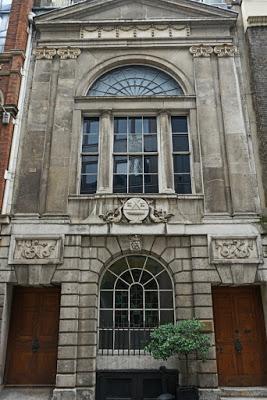
However, it's another City company whom we find next door in Watermen's Hall. The Company of Watermen was born in 1555, and since 1700 has represented both watermen (who carried passengers on the river) and lightermen (who carried cargo from ships to shore).
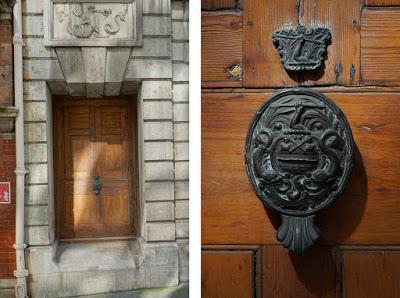
It continues to facilitate an apprenticeship scheme, and those apprentices can compete in the annual Doggett's Coat and Badge Race for a red coat and silver badge. Founded by Thomas Doggett in 1715 to mark George I's accession to the throne, the single sculling race has been run by the Fishmongers' Company since 1722. The prizes are awarded at Watermen's Hall, built in 1780.
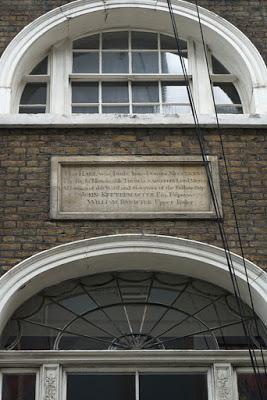
Next door is another hall, with a plaque proclaiming it was built in 1786. It was the home of the Fellowship Porters, a Company of tackle-porters and ticket-porters who landed and carried goods. According to an Accurate History of London written in 1805, 'Fellowship Porters land, ship off, carry or house, all merchandize, as corn, salt, coals, and other commodities, measurable by dry measure. Their number is from seven hundred to one thousand; and their chief governor the alderman of Billingsgate ward for the time being.' Ticket porters not only landed goods shipped to and from America, but undertook other porterage throughout the city: they wore metal tickets stamped with their names, which gave 'ample security for their fidelity and honesty'. Tackle porters were equipped with scales and weights, 'their business being to weigh such goods as come under their inspection.' The Accurate History describes an annual fellowship porters' custom carried out on this street:
by an act of common council, it was ordered that an annual sermon should be preached before them, in the parish church of St. Mary At Hill, the Sunday next after Midsummer Day; they, therefore, on the preceding night, furnish the merchants and respectable families in the neighbourhood with nosegays, and in the morning proceed from their hall to church, each having a large nosegay in his hand. On their arrival at the church, they walk up the middle aisle to the altar, and every porter deposits his benevolence for the use of the poor, and to defray the expenses of the day, into two basons provided for the purpose; and after having performed this ceremony, the deputy, merchants, with their wives, children, and servants, walk in order, from their separate pews, to perform the same solemnity. The nosegays used on this occasion are very expensive, and the custom is very antient.The Fellowship Porters seem to have had a strained relationship with the City of London which ended when they were disbanded in 1894. They had moved to Beer Lane by then; the Watermen bought the St Mary At Hill hall.
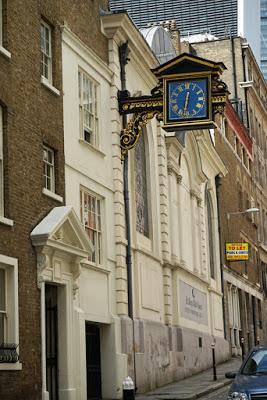
We now come to the church of the same name, St-Mary-At-Hill - and although it's hard to miss the very fine clock, we don't see an entrance. In fact, to reach it from this road you need to walk through a gateway, down a small passage, and into its courtyard.

An alternative route begins the other side of the church, through an entrance marked with a skull and crossbones.
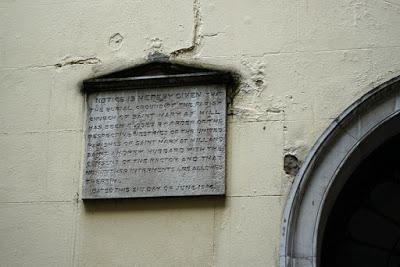
The church was rebuilt by Wren after suffering severe damage in the Great Fire of 1666, which started two streets away in Pudding Lane. Its courtyard was originally a graveyard. However, it was closed in 1846; the remains were moved to West Norwood Cemetery. A plaque informs us of the closure.This was part of a general movement to close the incredibly overcrowded, and consequently unsanitary and unpleasant, City burial grounds. Growth in the population meant a growth in the number of dead, and the need to bury them - and the temptation of bringing in burial fees - saw gravediggers disturbing or destroying earlier burials to fit new arrivals in. The early Victorians may not have understood bacteria, but they did believe that miasma - foul, stinking air - spread diseases, and many churchyards were shrouded in it. Eventually, new cemeteries were established at the edges of the city, with West Norwood opening in December 1837. The parish purchased its own plot in perpetuity within the new cemetery; sadly, it was subjected to a clearance in 1990 which was later challenged in Consistory Court.
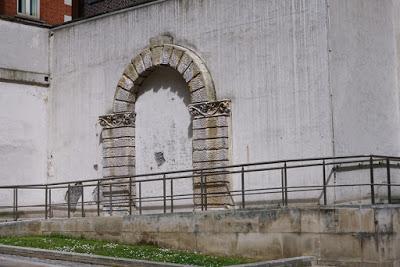
Before we leave the street, it's worth a quick glance at its east side: here, near the top of the road, is a rather isolated nineteenth-century archway set among the new buildings.

